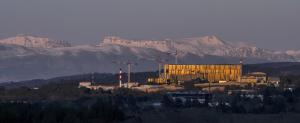An architectural paradox
There is something deliberately paradoxical in the architectural treatment of the ITER buildings.
On the one hand, the alternation between the mirror-like stainless steel and grey-lacquered metal chosen for cladding was designed to partly reflect the hues of the passing seasons and contribute to integrating the project harmoniously into the surrounding landscape. On the other hand, under specific light conditions such as a sunset in late winter, the cladding does exactly the opposite and turns some buildings fiery in a slowly darkening environment.
Taken from a curve in the road between the village of Saint-Paul-lez-Durance (ITER's "hometown") and the Mirabeau Bridge, the picture we publish today illustrates the latter. The use of a powerful telephoto lens reveals the beauty of the snow-capped mountains, which stand some 2,000 metres tall at a distance of 60 kilometres, and enhances the contrast and the harmony between man-made construction and the splendour of the natural setting.
Click here to view other images taken from the same viewpoint in previous years.


